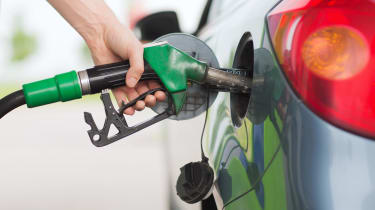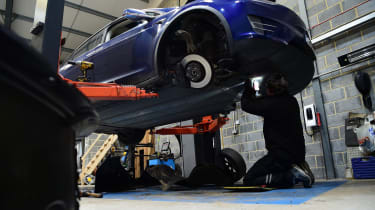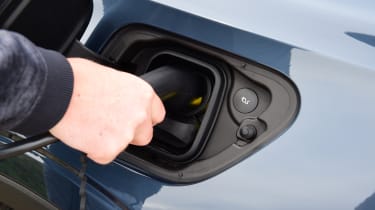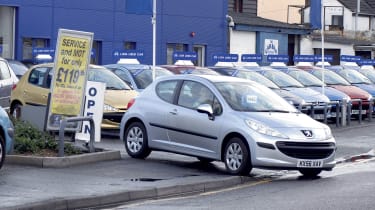Car costs explained: how to set your budget to buy and run a car
Working out how much a new car will cost you over the year should help make the ownership experience stress-free

Working out how much a new car will cost you over the years should help make the ownership experience stress-free.
It’s easy to fall into the temptation of buying the most expensive car you can afford based solely on asking price or monthly repayments. But while we all want to drive the best possible car and the purchase price is likely to be the headline-grabbing figure, insurance, servicing and fuel costs add up to a significant amount of money – often equal to the monthly repayments on a hire purchase deal or PCP contract.
Carbuyer's best economical 4x4s, SUVs and crossovers
It’s sensible to spend an hour or so with a calculator working out exactly how much a new car is going to cost to run before you decide to buy. There’s no point in stretching yourself to get the SUV of your dreams, if the fuel bills are likely to leave you broke and resentful over the course of ownership.
So read on for our guide on how to budget for a new car, which has all the tips you need to find the right model for you, taking all ownership costs into account.
Work out the basics: fuel and tax
Fuel and vehicle tax are the most obvious running costs for any car, so these should be the first things you think about once the purchase price has been considered.
Vehicle tax, often referred to as ‘road tax’, is fairly simple: the higher a car’s CO2 emissions are, the more it’ll cost you in the first year of vehicle tax – officially known as Vehicle Excise Duty, or VED. All petrol and diesels cars then command £180 per year, while alternative fuel vehicles like hybrids cost £170 per year. Zero-emissions cars – fully electric and hydrogen – are exempt.
Carbuyer's best road-tax-free cars
It’s important to remember that cars with a list price that’s over £40,000 are subject to a surcharge of £570 (£560 for alternative-fuel vehicles) from years two to six – essentially for five years after the first year’s CO2-weighted payment has been made. If you’re buying a new car, this will bring your annual bill to a hefty £750 (or £730 for alternative fuel cars) during that period.

The only exception to the above is with electric vehicles, which currently avoid both the year two to six surcharge, even if they cost more than £40,000 to buy.
Finding out how much CO2 a car emits is easy – just click on the ‘Prices & Specs’ tab of any Carbuyer review, then click on the engine and specification level you’re interested in and you’ll see the car’s emissions, tax band and associated annual charge.
Fuel costs can be a little harder to reliably calculate – while manufacturers give an official mpg (miles per gallon) figure, this is not necessarily a true reflection of what the car will achieve in real-world driving conditions. However, it’s useful for comparing cars: a car that claims 30mpg will generally go half as far on a tank as one that does 60mpg. It’s worth noting that higher economy figures offer diminishing returns in terms of cost though – a 40mpg car is 33 per cent more efficient than a 30mpg one, but a 60mpg car is only 20 per cent more efficient than a 50mpg one, despite the same 10mpg jump. So if you’re moving from an already economical car to another one, don’t base your decision on a jump of only a few mpg.
The introduction of a new WLTP test format in 2015 aimed to close the gap between a manufacturer’s published figures and those you’re likely to achieve in the real world, but while it’s more accurate than the old NEDC measurement, it’s still imperfect, so take official figures with a pinch of salt. The same applies to electric vehicles, which can often fall short of their official range estimates by dozens of miles.
To get a more accurate idea of how economical a car will be, take it on a long test drive if you have the option, and keep a close eye on the economy figure – typically displayed on the dashboard. Ask the dealer how to show you how to display this if you’re unsure, and don’t be fooled if they claim a poor mpg figure is because the car needs to be ‘run in’. Fuel economy may improve slightly once a car has a couple of thousand miles on the clock, but a 25mpg car won’t leap to 60mpg, however well run-in it is.
Calculating economy and saving money on fuel
The next thing to do is calculate how much the car is likely to cost to fuel for a year based on these figures. If you cover 8,000 miles a year (the UK average), then a car that returns 40mpg in real-world conditions will use 200 gallons of fuel annually. Confusingly, while economy is measured in gallons, petrol is priced and sold per litre, so you’ll need a calculator.
There are about 4.55 litres to a UK gallon, so if petrol costs about £1.44 a litre, the average at the time of writing, a car that returns 40mpg should cost roughly £1,300 a year to fuel

If the annual fuel costs you’ve calculated are looking a little scary, remember that the way you drive is as important as the car you’re driving if you want to reduce fuel consumption. You can make significant savings by remembering a few simple driving tips.
Firstly, although it sounds obvious, driving a little slower than you normally would means you won’t use as much fuel getting up to and maintaining speed. And while brisk acceleration is good, as getting up to a cruising speed quickly and using light pressure on the accelerator to hold it uses less fuel than accelerating slowly over a longer period, hard acceleration, only to have to slow down again, uses far more fuel.
It pays to look ahead and anticipate the flow of traffic too – it won’t just mean a smoother ride for you and your passengers, but less fuel wasted on unnecessary deceleration and acceleration. And if you do have to come to a halt, make use of features like auto stop-start, which can turn off the engine rather than idling in traffic. This isn’t an issue for electric cars of course, but the other tips will still help you stretch an EV’s range too.
Servicing
Most cars need servicing annually. During a service, the engine oil and filter will be changed, any scheduled maintenance will be taken care of and the car should receive a mechanical once-over to ensure it’s in good condition. Servicing costs vary wildly: the cheapest models should cost as little as £150 each time, while some high-performance cars can cost 10 times that to get looked at. Make sure you know which camp a car you’re thinking of falls into. That said, some new electric models, even more expensive ones, can be surprisingly affordable to service, with fewer fluids and filters to replace – some services may involve more of a visual check.

Many manufacturers now offer fixed-price servicing plans on new cars. These allow you to pay an upfront or monthly fee, rather than just paying at service time each year. This makes budgeting easier and can save you money, too.
If no fixed-price servicing plan is available, it’s well worth ringing around a few garages – both independent and franchised – to get quotes for a service before buying a new car. While independent garages may be less expensive than main dealers, you need to make sure they service your car in line with manufacturer recommendations and use official approved parts, in order to preserve the car’s manufacturer warranty cover.
It’s also worth bearing in mind that dealers appreciate the loyalty shown if you use them for servicing and this can result in goodwill gestures if anything goes wrong with your car outside of warranty – although you should consider this a bonus rather than an expectation. Many main dealers will also match servicing quotes from an independent garage and throw in perks like free roadside assistance for the year.
Depreciation
As soon as you drive your new car away from the dealership, it’s considered ‘used’ and starts to lose money. Many cars are worth only half their original purchase price after three years of ownership.
How much a car depreciates is determined by a number of factors, but what model you choose has the biggest bearing. While a large, thirsty saloon may lose up to 70% of its value in three years, a desirable and economical small hatchback could drop by just over 30% in the same period.
Depreciation figures can vary hugely though, even in a single model range – if the market deems one trim level, engine, transmission and colour combination more than another, that car will depreciate more slowly. Lease costs are actually a good indicator of depreciation. If a car seems unusually affordable compared to a similar model, that’s probably because the lease firm knows it will get a higher proportion of the car’s value back at the end of the term, so can offer a better deal.
Whichever model you choose, be sure to factor depreciation into your budget; it’s a good idea to know roughly how much the car will be worth when you’re likely to trade it in or sell it on. Our guide on how to minimise a car’s depreciation has more information.
Insurance
The cost of car insurance varies enormously based on a number of factors – one of which is the type of car you’re insuring. Make sure to check how much any car you’re thinking of buying will cost to insure. The best way of doing this is to register with a price-comparison website. Once you’ve done this, getting quotes for different cars is relatively quick and straightforward.

There are some factors that will affect your insurance irrespective of the car you choose, such as where you live, and your own personal driving experience and history. But the insurance groups provided by the manufacturer will give you a reasonable idea of how much a car is likely to cost relative to others, while choosing models with good safety and security features – both of which mitigate risk for an insurer, based on factors like personal injury risk and theft of or from a vehicle – can help you save a little money on insurance.
Our comprehensive guide to car insurance has more details, and make sure to check out our list of cheap cars to insure, too.
Petrol, diesel, hybrid, plug-in hybrid, or electric?
Buyers have never had a greater choice of powertrains than they do today. While petrol and diesel cars have nearly always been around, hybrid drivetrains began to take off in the early 2000s and over the past decade, plug-in hybrid models and pure battery electric cars have appeared in huge numbers.
All still offer useful characteristics depending on your budget, driving style, and what kind of journeys you tend to do. You’ll find petrol powering some of the most affordable models on sale, and while diesel has fallen from grace following the well-publicised Dieselgate scandal in 2015, it’s still nearly unmatched for long-distance drivers – diesel cars can cover huge distances on a tank of fuel and the latest models are incredibly economical. They’re less ideal for regular short journeys; some of the components diesels use to clean up their emissions can deteriorate if they never fully come up to temperature.
Hybrid has begun to take over from diesel in many cars though, in both mild hybrid and full hybrid forms. The former tends to use some form of energy recuperation to reduce the fuel consumption of a petrol model, while the latter will usually allow for travelling small distances entirely on electric power. Hybrids used to be expensive but you’ll increasingly find them in more affordable cars – even budget brand Dacia now offers a hybrid version of the Dacia Jogger MPV. They’re an ideal way of saving fuel for those who either can’t afford or can’t live with a plug-in model.

Plug-in hybrids are a halfway step between hybrids and fully electric vehicles. They’ll usually offer a higher proportion of electric running thanks to a larger battery pack (which must be plugged in to take full advantage of) and more powerful electric assistance. They’re useful for drivers who might like to take advantage of electric running on short journeys (and take advantage of the tax benefits that come from a plug-in hybrid’s low CO2 figures), while also benefiting from the easy long-distance capabilities of a combustion engine.
Then of course we have full battery electric cars, typically referred to as EVs, for electric vehicles. While they’re almost always more expensive to buy than petrol, diesel or hybrid cars, they can be cheaper to run, since electricity is (usually) less expensive than fuel, and their simplicity makes them easier and cheaper to service and in theory, more reliable. The earliest EVs were really suitable only for short trips but more recently, it’s been possible to buy electric cars capable of 200, 300, even 400 miles or more. Charging times have also improved, though public chargers can still unfortunately be both unreliable and in some cases, more expensive than filling a combustion vehicle for a given distance.
Used cars
The last few years saw significant fluctuations in the price of used cars, as short supply of new vehicles meant consumers were holding onto their used cars for longer just as people looking to swap into a new car were short on choice, and prepared to spend more on a used one in the interim.
These higher prices still haven’t quite settled, but while this means your money doesn’t go quite as far as it used to, a second-hand car can still offer attractive value. Standards of reliability and rust resistance have been going up for decades, so the average used car today, even a decade-old one, will be in far better shape than its equivalent thirty or forty years ago. Buy wisely and you can end up with a car that costs you thousands less than an equivalent new model, and if you can live without the reassurance of a new car warranty, will likely be just as easy and affordable to run.

There is a caveat to this though, and it’s particularly apparent with models that cost a lot more to buy new, and have since depreciated at a heavy rate. The general rule of thumb is that if you couldn’t afford to run a certain model of car when it was new, you probably won’t be able to once it has a few thousand miles on the clock. A fifteen-year-old Mercedes S-class for ten grand seems incredibly tempting, but it’ll still have the servicing costs, parts prices, insurance costs and fuel consumption commensurate with the seventy grand it might have cost when new.
Alternative fuel vehicles (AFVs)
Buying a plug-in hybrid or electric vehicle can radically alter your motoring budget. These tend to be more expensive to purchase but offer from 20 to around 300 miles of pure electric driving range. As you'll know, electricity is far cheaper than petrol or diesel, with most EVs costing just a few pounds to top up, or even less if you're fortunate enough to have solar panels or a wind generator. Buying an EV can also qualify you for a government plug-in car grant, although this was axed for plug-in hybrids in November 2018.
Other costs
It’s a good idea to think about how you use your car on a day-to-day basis: if you regularly drive into London, buying a car that’s exempt from the Congestion Charge and Ultra Low Emission Zone can save you a lot of money. Our guide to the best London Congestion Charge exempt cars is well worth a look if the capital is a frequent destination.
Also, take parking charges and/or residents’ parking permits into account. These may seem like fine details, but having a comprehensive idea what your car will cost can help you figure in all the factors fully. Many people find that a separate ‘car fund’ bank account helps to thoroughly budget for a car.
Example: Four-year agreement, assuming the car is handed back at the end of the term
| List price, no options | |
| 2023 Volkswagen Golf Life 1.0 TSI (110PS) five-door | £26,565 |
| PCP cost | |
| Total deposit: £5,313 (customer), £2,000 (VW deposit contribution) | £7,313 |
| 47 monthly payments of £267.32 @ 6.9% APR | £12,564 |
| Total payable (assuming no balloon payment) | £19,877 |
| VED (vehicle tax) | |
| 122g/km = £210 year one, £180 for next three years | £750 |
| Fuel | |
| 8,000 miles per year at 52mpg, four years | £4,042 |
| Insurance | |
| Group 19, £400 per year est | £1,600 |
| Parking | |
| Parking permit (Birmingham est. £250 per year) | £1,000 |
| Servicing | |
| VW fixed cost, £480 upfront, 48x £20 per month | £1,440 |
| Four-year total | £28,709 |
| Yearly total | £7,177 |
Most Popular
Tips & advice

Car dashboard warning lights: what does each symbol mean?

Electric car charging stations: public networks, charger types, apps and maps






